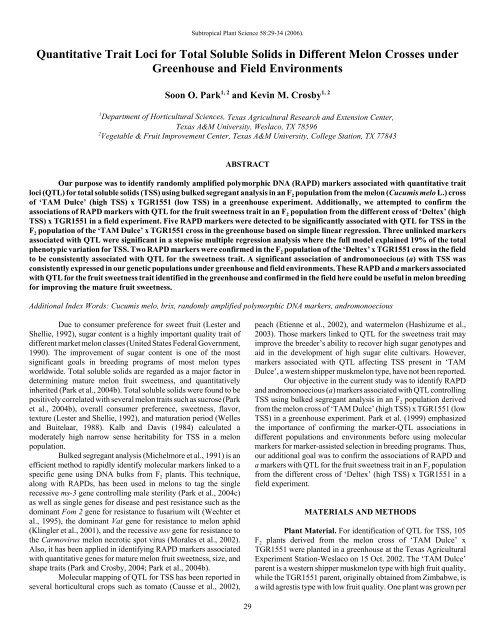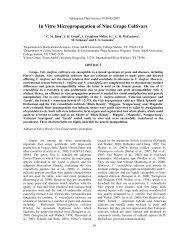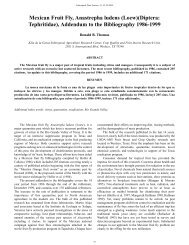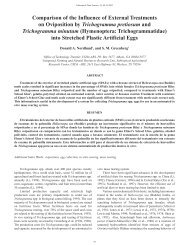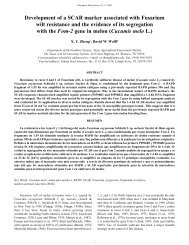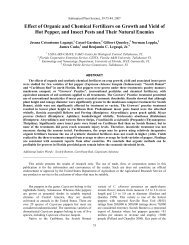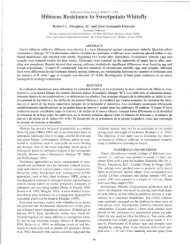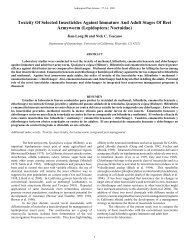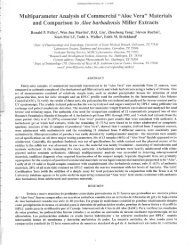Subtropical Plant Sci. J. 58:29-34. - Subtropical Plant Science Society
Subtropical Plant Sci. J. 58:29-34. - Subtropical Plant Science Society
Subtropical Plant Sci. J. 58:29-34. - Subtropical Plant Science Society
You also want an ePaper? Increase the reach of your titles
YUMPU automatically turns print PDFs into web optimized ePapers that Google loves.
<strong>Subtropical</strong> <strong>Plant</strong> <strong>Sci</strong>ence <strong>58</strong>:<strong>29</strong>-34 (2006).<br />
Quantitative Trait Loci for Total Soluble Solids in Different Melon Crosses under<br />
Greenhouse and Field Environments<br />
Soon O. Park 1, 2 and Kevin M. Crosby 1, 2<br />
1 Department of Horticultural <strong>Sci</strong>ences, Texas Agricultural Research and Extension Center,<br />
Texas A&M University, Weslaco, TX 78596<br />
2 Vegetable & Fruit Improvement Center, Texas A&M University, College Station, TX 77843<br />
ABSTRACT<br />
Our purpose was to identify randomly amplified polymorphic DNA (RAPD) markers associated with quantitative trait<br />
loci (QTL) for total soluble solids (TSS) using bulked segregant analysis in an F 2 population from the melon (Cucumis melo L.) cross<br />
of ‘TAM Dulce’ (high TSS) x TGR1551 (low TSS) in a greenhouse experiment. Additionally, we attempted to confirm the<br />
associations of RAPD markers with QTL for the fruit sweetness trait in an F 2 population from the different cross of ‘Deltex’ (high<br />
TSS) x TGR1551 in a field experiment. Five RAPD markers were detected to be significantly associated with QTL for TSS in the<br />
F 2 population of the ‘TAM Dulce’ x TGR1551 cross in the greenhouse based on simple linear regression. Three unlinked markers<br />
associated with QTL were significant in a stepwise multiple regression analysis where the full model explained 19% of the total<br />
phenotypic variation for TSS. Two RAPD markers were confirmed in the F 2 population of the ‘Deltex’ x TGR1551 cross in the field<br />
to be consistently associated with QTL for the sweetness trait. A significant association of andromonoecious (a) with TSS was<br />
consistently expressed in our genetic populations under greenhouse and field environments. These RAPD and a markers associated<br />
with QTL for the fruit sweetness trait identified in the greenhouse and confirmed in the field here could be useful in melon breeding<br />
for improving the mature fruit sweetness.<br />
Additional Index Words: Cucumis melo, brix, randomly amplified polymorphic DNA markers, andromonoecious<br />
Due to consumer preference for sweet fruit (Lester and<br />
Shellie, 1992), sugar content is a highly important quality trait of<br />
different market melon classes (United States Federal Government,<br />
1990). The improvement of sugar content is one of the most<br />
significant goals in breeding programs of most melon types<br />
worldwide. Total soluble solids are regarded as a major factor in<br />
determining mature melon fruit sweetness, and quantitatively<br />
inherited (Park et al., 2004b). Total soluble solids were found to be<br />
positively correlated with several melon traits such as sucrose (Park<br />
et al., 2004b), overall consumer preference, sweetness, flavor,<br />
texture (Lester and Shellie, 1992), and maturation period (Welles<br />
and Buitelaar, 1988). Kalb and Davis (1984) calculated a<br />
moderately high narrow sense heritability for TSS in a melon<br />
population.<br />
Bulked segregant analysis (Michelmore et al., 1991) is an<br />
efficient method to rapidly identify molecular markers linked to a<br />
specific gene using DNA bulks from F 2 plants. This technique,<br />
along with RAPDs, has been used in melons to tag the single<br />
recessive ms-3 gene controlling male sterility (Park et al., 2004c)<br />
as well as single genes for disease and pest resistance such as the<br />
dominant Fom 2 gene for resistance to fusarium wilt (Wechter et<br />
al., 1995), the dominant Vat gene for resistance to melon aphid<br />
(Klingler et al., 2001), and the recessive nsv gene for resistance to<br />
the Carmovirus melon necrotic spot virus (Morales et al., 2002).<br />
Also, it has been applied in identifying RAPD markers associated<br />
with quantitative genes for mature melon fruit sweetness, size, and<br />
shape traits (Park and Crosby, 2004; Park et al., 2004b).<br />
Molecular mapping of QTL for TSS has been reported in<br />
several horticultural crops such as tomato (Causse et al., 2002),<br />
peach (Etienne et al., 2002), and watermelon (Hashizume et al.,<br />
2003). Those markers linked to QTL for the sweetness trait may<br />
improve the breeder’s ability to recover high sugar genotypes and<br />
aid in the development of high sugar elite cultivars. However,<br />
markers associated with QTL affecting TSS present in ‘TAM<br />
Dulce’, a western shipper muskmelon type, have not been reported.<br />
Our objective in the current study was to identify RAPD<br />
and andromonoecious (a) markers associated with QTL controlling<br />
TSS using bulked segregant analysis in an F 2 population derived<br />
from the melon cross of ‘TAM Dulce’ (high TSS) x TGR1551 (low<br />
TSS) in a greenhouse experiment. Park et al. (1999) emphasized<br />
the importance of confirming the marker-QTL associations in<br />
different populations and environments before using molecular<br />
markers for marker-assisted selection in breeding programs. Thus,<br />
our additional goal was to confirm the associations of RAPD and<br />
a markers with QTL for the fruit sweetness trait in an F 2 population<br />
from the different cross of ‘Deltex’ (high TSS) x TGR1551 in a<br />
field experiment.<br />
MATERIALS AND METHODS<br />
<strong>Plant</strong> Material. For identification of QTL for TSS, 105<br />
F 2 plants derived from the melon cross of ‘TAM Dulce’ x<br />
TGR1551 were planted in a greenhouse at the Texas Agricultural<br />
Experiment Station-Weslaco on 15 Oct. 2002. The ‘TAM Dulce’<br />
parent is a western shipper muskmelon type with high fruit quality,<br />
while the TGR1551 parent, originally obtained from Zimbabwe, is<br />
a wild agrestis type with low fruit quality. One plant was grown per<br />
<strong>29</strong>
<strong>Subtropical</strong> <strong>Plant</strong> <strong>Sci</strong>ence <strong>58</strong>:<strong>29</strong>-34 (2006).<br />
11 L pot containing soil-less media, Sunshine Mix #4 (Sun Gro<br />
Horticulture Inc., Bellevue, Wash.). Peters 20N-8.7P-16.6K water<br />
soluble fertilizer (Scotts, Marysville, Ohio) was applied weekly.<br />
Pesticides were applied as needed to control diseases. Approximate<br />
day/night greenhouse temperatures were 25±3/22±2 EC. Day<br />
lengths ranged from 12 to 10 h light in this experiment.<br />
For confirmation of the marker-QTL associations, 64 F 2<br />
plants from the cross of ‘Deltex’ x TGR1551 were planted on black<br />
plastic mulch with drip irrigation on sandy clay loam soil at<br />
Weslaco, Texas on 10 Mar. 2002. The high sugar ‘Deltex’ parent<br />
is a commercial ananas cultivar (Nunhems, Parma, Idaho). Single<br />
bed length and width were 31.7 m and 1.0 m, respectively, with<br />
30.5 cm spacing between plants and 1.0 m between beds. A<br />
fertilizer containing 5N-11.3P-27.4K (Wilbur Ellis, Edinburg,<br />
Texas) was applied weekly. Irrigation was supplied as needed.<br />
Approximate day/night field temperatures were 30±3/23±3 EC. Day<br />
lengths ranged from 12 to 14 h light.<br />
Data Collection. Data for TSS were obtained from the<br />
two parental pairs as well as the 105 and 64 F 2 plants using a<br />
temperature corrected refractometer with digital readout (Reichert<br />
<strong>Sci</strong>entific Instruments, Buffalo, N.Y.). Stamen presence and<br />
absence in female flowers were checked thrice on all F 2 plants and<br />
parents at different times during flowering.<br />
RAPD. Fully expanded leaves of the 105 and 64 F 2 plants<br />
along with their parental pairs were collected at 21 days after<br />
planting. Total genomic DNA was extracted from the leaf tissue<br />
using the method of Skroch and Nienhuis (1995). A total of 500<br />
random 10-mer primers (Operon Technologies, Alameda, Calif.)<br />
were used for the RAPD analysis (Williams et al., 1990).<br />
Polymerase chain reactions (PCR) were performed on 96-well<br />
plates in a MJ Research thermalcycler (model PTC-0100; MJ<br />
Research, Waltham, Mass.). Protocols for PCR and the<br />
composition of the final volume of reactants were the same as those<br />
described by Skroch and Nienhuis (1995). A 100-base pair (bp)<br />
DNA ladder (Life Technologies, Grand Island, N.Y.) was used to<br />
estimate the length of RAPD markers. The name of each RAPD<br />
marker is derived from an “O” prefix for Operon primers, the<br />
letters identifying the Operon kit, Operon primer number, and the<br />
approximate length (bp) of the marker (Park et al., 2004a).<br />
Bulked Segregant Analysis. Two low and high bulks were<br />
prepared from equal volumes of standardized DNA (10 ng . μL -1 )<br />
from eight selected F 2 plants of the ‘TAM Dulce’ x TGR1551 cross<br />
with the highest and lowest TSS values, respectively. The 500<br />
primers were used to simultaneously screen between the low and<br />
high DNA bulks, and between the parents ‘TAM Dulce’ and<br />
TGR1551. Primers that generated marker polymorphisms between<br />
the low and high DNA bulks were tested in the F 2 population from<br />
the cross between ‘TAM Dulce’ and TGR1551 for identifying<br />
QTL. Four primers were tested in the F 2 population of the ‘Deltex’<br />
x TGR1551 cross for confirming the RAPD marker-QTL<br />
associations.<br />
Linkage Analysis. To detect segregation distortion of<br />
markers and andromonoecious, F 2 population marker data were<br />
tested for goodness-of-fit to a 3:1 ratio using the chi-square test.<br />
Due to the dominant nature of RAPD markers, the linkage analyses<br />
of two markers obtained from ‘TAM Dulce’ and four markers<br />
including a obtained from TGR1551 were separately performed on<br />
the data for 105 F 2 plants of the ‘TAM Dulce’ x TGR1551 cross<br />
using MAPMAKER version 3.0 (Lander et al., 1987). We also<br />
executed separately the linkage analyses of two markers from<br />
‘Deltex’ and two markers from TGR1551 on the data for 64 F 2<br />
plants of the ‘Deltex’ x TGR1551 cross.<br />
Detection of QTL. Simple linear regression, for each<br />
pairwise combination of quantitative traits and marker loci, was<br />
used to analyze the greenhouse and field data for detection and<br />
confirmation of QTL for TSS. Significant differences in trait<br />
associations were based on F-tests (P
<strong>Subtropical</strong> <strong>Plant</strong> <strong>Sci</strong>ence <strong>58</strong>:<strong>29</strong>-34 (2006).<br />
Table 1. Pearson correlations of total soluble solids (TSS) with other fruit sweetness traits in two F 2 populations<br />
derived from melon crosses of ‘TAM Dulce’ x TGR1551 (TT) and ‘Deltex’ x TGR1551 (DT) in greenhouse and<br />
field experiments.<br />
Fruit sweetness traits<br />
Trait Cross Sucrose Glucose Fructose SPTS z GPTS FPTS<br />
TT 0.66** 0.90** 0.96** 0.33** -0.16 NS -0.37**<br />
TSS<br />
DT 0.57** -0.20 NS -0.08 NS 0.53** -0.52** -0.48**<br />
z SPTS=sucrose percentage of total sugars, GPTS=glucose percentage of total sugars, FPTS=fructose percentage of<br />
total sugars.<br />
NS ,**Nonsignificant or significant at P < 0.01.<br />
explained by the identified QTL (Paterson et al., 1991). Pearson<br />
correlations of mature fruit sweetness traits were also determined<br />
in our populations. All statistical analyses were conducted using the<br />
Statistical Analysis System (SAS Inst., Cary, N.C.).<br />
RESULTS AND DISCUSSION<br />
Frequency Distribution. A clear separation was observed<br />
for TSS content between ‘TAM Dulce’ and TGR1551 in the<br />
greenhouse experiment (Fig. 1). Mature fruits of ‘TAM Dulce’ had<br />
high TSS (9.1-12.5%) content. In contrast, those of TGR1551<br />
possessed low TSS (3.8-5.8%) content. Fruits of all F 1 plants<br />
derived from the ‘TAM Dulce’ x TGR1551 cross had intermediate<br />
TSS content (Fig. 1). A continuous frequency distribution for TSS<br />
content was noted for F 2 plants of the ‘TAM Dulce’ x TGR1551<br />
cross in the greenhouse (Fig. 1), indicating that the fruit sweetness<br />
trait was quantitatively inherited. In addition, a continuous<br />
distribution for the sweetness trait was observed for F 2 plants of the<br />
Figure. 2. RAPD marker OAS03.450 expressing polymorphism<br />
between the low soluble solids parent TGR1551 and the high<br />
soluble solids parent ‘TAM Dulce’, and its segregation in low and<br />
high soluble solids F 2 plants of the ‘TAM Dulce’ x TGR1551 cross<br />
grown in the greenhouse. 1 to 7=greenhouse F 2 plants,<br />
8=TGR1551, 9=‘TAM Dulce’, and 10=a 100-bp DNA marker<br />
ladder.<br />
‘Deltex’ x TGR1551 cross in the field experiment (Fig. 1)<br />
consistent with the quantitative inheritance for the trait. The<br />
quantitative inheritance pattern of TSS concentration in this study<br />
was similar to that reported previously in other horticultural crops<br />
(Causse et al., 2002; Etienne et al., 2002; Georgelis et al., 2004;<br />
Hashizume et al., 2003; Paterson et al., 1991) as well as melon<br />
(Burger et al., 2002). Low (0.23), intermediate (0.63-0.66), and<br />
high (0.75) estimates of narrow sense heritability for TSS were<br />
reported in several genetically different melon populations (Burger<br />
et al., 2002; Kalb and Davis, 1984).<br />
Correlation. Total soluble solids were significantly and<br />
positively correlated with sucrose and sucrose percentage of total<br />
sugars in the two F 2 populations in the greenhouse and field<br />
experiments (Table 1), indicating that selection of the three fruit<br />
sweetness traits is feasible. The positive correlation between TSS<br />
and sucrose was nearly the same as that reported previously in<br />
peach by Etienne et al. (2002). A significant negative correlation of<br />
TSS with fructose percentage of total sugars was found in the two<br />
genetic populations.<br />
Identification of QTL. A total of 500 primers were used<br />
for the RAPD analysis of two different bulks for TSS developed<br />
from selected greenhouse F 2 plants with low and high values along<br />
with their parents ‘TAM Dulce’ and TGR1551. Five RAPD<br />
markers were polymorphic between the two different DNA bulks.<br />
Two displayed an amplified DNA fragment in the high bulk that<br />
was absent in the low bulk. Three showed an amplified DNA<br />
fragment in the low bulk that was absent in the high bulk. An<br />
example of marker OAS03.450 is shown in Fig. 2. These five<br />
marker fragments segregated in the F 2 population of the cross<br />
‘TAM Dulce’ x TGR1551. A goodness-of-fit to a 3:1 ratio for band<br />
presence to band absence for each of the five markers was observed<br />
in 105 F 2 plants (Table 2). These markers were unlinked based on<br />
linkage analysis. A total of six genetic markers including five<br />
RAPDs and andromonoecious were identified to be significantly<br />
associated with QTL affecting TSS content in the F 2 population of<br />
the ‘TAM Dulce’ x TGR1551 cross in the greenhouse experiment<br />
based on simple linear regression (Table 3). Two markers were<br />
amplified from ‘TAM Dulce’, while four markers were generated<br />
from TGR1551. The high TSS parent ‘TAM Dulce’ contributed<br />
high TSS alleles for these six markers. Markers OAW06.1250 from<br />
‘TAM Dulce’ and OAS03.450 from TGR1551 explained 9% and<br />
8% of the variation for the TSS content, respectively. Also,<br />
OAT03.250, OAP03.800, OAW06.600, and the a locus accounted<br />
31
<strong>Subtropical</strong> <strong>Plant</strong> <strong>Sci</strong>ence <strong>58</strong>:<strong>29</strong>-34 (2006).<br />
Table 2. Chi-square analyses for segregation of five RAPD markers and andromonoecious (a) associated with total soluble<br />
solids in two F 2 populations derived from melon crosses of ‘TAM Dulce’ x TGR1551 (TT) and ‘Deltex’ x TGR1551 (DT).<br />
TT plants (no.)<br />
DT plants (no.)<br />
Marker z Source Presence Absence Ratio χ 2 P Presence Absence Ratio χ 2 P<br />
OAW06.1250 TAM Dulce & Deltex 80 25 3:1 0.02 0.87 55 9 3:1 3.52 0.06<br />
OAT03.250 TAM Dulce & Deltex 75 30 3:1 0.53 0.46 44 20 3:1 1.01 0.31<br />
OAP03.800 TGR1551 & Deltex 81 24 3:1 0.15 0.69 3:1<br />
OAS03.450 TGR1551 70 35 3:1 3.45 0.06 41 23 3:1 3.52 0.06<br />
OAW06.600 TGR1551 & Deltex 80 25 3:1 0.02 0.87 3:1<br />
a TGR1551 74 31 3:1 0.91 0.34 45 19 3:1 0.52 0.47<br />
(monoecious)<br />
z No segregation of OAP03.800 and OAW06.600 in the DT F 2 population.<br />
(monoecious)<br />
(andromonoecious)<br />
(andromonoecious)<br />
for 4% to 7% of the TSS variation. The two unlinked makers from<br />
‘TAM Dulce’ and the three unlinked markers from TGR1551<br />
explaining 14% and 19% of the total phenotypic variation for the<br />
trait, respectively, were significant in the stepwise multiple<br />
regression analysis (Table 3).<br />
RAPD markers linked to quantitative genes for fruit size<br />
and shape traits as well as qualitative genes for pest and disease<br />
resistance have been detected successfully by bulked segregant<br />
analysis in melons (Klingler et al., 2001; Morales et al., 2002; Park<br />
and Crosby, 2004; Wechter et al., 1995). In tomato, peach, and<br />
watermelon one to two major QTL influencing soluble solids<br />
content were observed by several investigators (Causse et al., 2002;<br />
Etienne et al., 2002; Georgelis et al., 2004; Hashizume et al., 2003),<br />
while seven minor QTL related to the TSS content in tomato were<br />
found by Paterson et al. (1991). This is the first report of molecular<br />
markers associated with QTL affecting TSS in melon using bulked<br />
segregant analysis. These RAPD markers and the andromonoecious<br />
trait associated with the TSS QTL could be useful to transfer these<br />
genes into a low sugar cultivar or breeding line to enhance the<br />
mature melon fruit sweetness.<br />
Confirmation of QTL. The associations of the RAPD<br />
and andromonoecious markers with QTL for the fruit sweetness<br />
trait identified in the F 2 population of the ‘TAM Dulce’ x TGR1551<br />
cross in the greenhouse needed to be continued in other populations<br />
of the same cross and or a different cross in different environments<br />
to substantiate their merit in melon breeding. Of the five RAPD<br />
markers associated with the fruit sweetness trait detected in the<br />
greenhouse population, three were also polymorphic between the<br />
parents ‘Deltex’ and TGR1551, utilized to create the F 2 population<br />
from which the fruit sweetness trait was evaluated in the field<br />
experiment (Table 2). Due to no segregation of OAP03.800 and<br />
OAW06.600 in the parents ‘Deltex’ and TGR1551, the remaining<br />
two markers were not tested for confirming the marker-QTL<br />
association. All three markers also segregated in the F 2 population<br />
of the ‘Deltex’ x TGR1551 cross. A 3:1 goodness-of-fit ratio for<br />
band presence to band absence for each of the three markers, two<br />
amplified from ‘Deltex’ and one amplified from TGR1551, was<br />
observed in the field population (Table 2).<br />
Two RAPD markers associated with the fruit sweetness<br />
trait in the greenhouse experiment were confirmed in the F 2<br />
population of the ‘Deltex’ x TGR1551 cross in the field experiment<br />
to be consistently associated with QTL for the sweetness trait<br />
Table 3. Simple linear regression (SLR) and stepwise multiple regression (SMR) analyses of marker and data for<br />
detection of QTL for total soluble solids in an F 2 population derived from the melon cross of ‘TAM Dulce’ (high<br />
total soluble solids) x TGR1551 (low total soluble solids) in the greenhouse experiment.<br />
SLR Average value SMR<br />
RAPD marker Source P R 2 (%) Presence Absence P R 2 (%)<br />
OAW06.1250 TAM Dulce 0.001 9 6.8 z 5.2 y 0.001 9<br />
OAT03.250 TAM Dulce 0.0<strong>29</strong> 5 6.7 5.7 0.014 5<br />
Cumulative R 2 = 14<br />
OAS03.450 TGR1551 0.004 8 6.1 7.0 0.004 8<br />
OAP03.800 TGR1551 0.005 7 6.1 7.5 0.011 6<br />
OAW06.600 TGR1551 0.010 6 6.1 7.3 0.011 5<br />
a x TGR1551 0.044 4 6.2 7.1<br />
Cumulative R 2 = 19<br />
z An average value of F 2 plants with band presence for the marker.<br />
y<br />
An average value of F 2 plants with band absence for the marker.<br />
x Andromonoecious.<br />
32
<strong>Subtropical</strong> <strong>Plant</strong> <strong>Sci</strong>ence <strong>58</strong>:<strong>29</strong>-34 (2006).<br />
Table 4. Confirmation of RAPD markers and andromonoecious (a) associated with QTL for total soluble<br />
solids in an F 2 population derived from the melon cross of ‘Deltex’ (high total soluble solids) x TGR1551<br />
(low total soluble solids) in the field experiment.<br />
Simple linear regression Stepwise multiple regression<br />
Marker Source Linkage P R 2 (%) P R 2 (%)<br />
a TGR1551 Unlinked 0.000 18 0.000 18<br />
OAS03.450 TGR1551 Unlinked 0.000 17 0.000 17<br />
OAW06.1250 Deltex Unlinked 0.046 4<br />
Cumulative R 2 = 35<br />
on the basis of simple linear regression (Table 4). Marker<br />
OAS03.450 obtained from TGR1551, associated with QTL for the<br />
fruit sweetness trait in the greenhouse population, was also found<br />
to be significantly associated with QTL for the sweetness trait in<br />
the field population, and accounted for 17% of the phenotypic<br />
variation for the trait. A significant association of OAW06.1250<br />
from ‘Deltex’ with QTL for the fruit sweetness trait was<br />
consistently expressed in our populations derived from two<br />
different crosses under greenhouse and field environments. The<br />
andromonoecious locus on linkage group 4 of the classical melon<br />
map regulating stamen absence or stamen presence in female<br />
flowers was also significantly associated with the sweetness trait in<br />
the field, and explained 18% of the TSS variation. However,<br />
marker OAT03.250 from ‘Deltex’, slightly associated with the TSS<br />
content identified in the greenhouse F 2 population, was not<br />
confirmed in this field F 2 population. The RAPD and a markers<br />
linked to the TSS QTL identified and confirmed in two populations<br />
and environments in this study should be more reliable for markerassisted<br />
selection than those evaluated in a single population and<br />
environment.<br />
ACKNOWLEDGMENTS<br />
This research was funded in part by USDA Grant: 2001-<br />
34402-10543, ‘Designing Foods for Health’. We acknowledge<br />
financial support from the South Texas Melon Committee. We also<br />
thank technicians, Alfredo Rodríguez and Hyun J. Kang, Texas<br />
Agricultural Research and Extension Center-Weslaco, Texas A&M<br />
University, for their assistance.<br />
LITERATURE CITED<br />
Burger, Y., U. Saar, N. Katzir, H. Paris, Y. Yeselson, I. Levin, and<br />
A. Schaffer. 2002. A single recessive gene for sucrose<br />
accumulation in Cucumis melo fruit. J. Amer. Soc. Hort. <strong>Sci</strong>.<br />
127:938-943.<br />
Causse, M., V. Saliba-Colombani, L. Lecomte, P. Duffe, P.<br />
Rousselle, and M. Buret. 2002. QTL analysis of fruit quality<br />
in fresh market tomato: A few chromosomal regions control<br />
the variation of sensory and instrumental traits. J. Expt. Bot.<br />
53:2089-2098.<br />
Edwards, M.D., C.W. Stuber, and J.F. Wendell. 1987. Molecular<br />
marker-facilitated investigations of quantitative trait loci in<br />
maize. I. Numbers, genomic distribution, and types of gene<br />
action. Genetics 116:113-125.<br />
Etienne, C., C. Rothan, A Moing, C. Plomion, C. Bodenes, L.<br />
Svanella-Dumas, P. Cosson, V. Pronier, R. Monet, and E.<br />
Dirlewanger. 2002. Candidate genes and QTLs for sugar and<br />
organic acid content in peach [Prunus persica (L.) Batsch].<br />
Theor. Appl. Genet.105:145-159.<br />
Georgelis, N., J.W. Scott, and E.A. Baldwin. 2004. Relationship of<br />
tomato fruit sugar concentration with physical and chemical<br />
traits and linkage of RAPD markers. J. Amer. Soc. Hort. <strong>Sci</strong>.<br />
1<strong>29</strong>:839-845.<br />
Hashizume, T., I. Shimamoto, and M. Hirai. 2003. Construction of<br />
a linkage map and QTL analysis of horticultural traits for<br />
watermelon [Citrullus lanatus (Thunb.) Matsum and Nakai]<br />
using RAPD, RFLP and ISSR markers. Theor. Appl. Genet.<br />
106:779-785.<br />
Kalb, T.J. and D.W. Davis. 1984. Evaluation of combining ability,<br />
heterosis, and genetic variance for fruit quality characteristics<br />
in bush muskmelon. J. Amer. Soc. Hort. <strong>Sci</strong>. 109:411-415.<br />
Klingler, J., I. Kovalski, L. Silberstein, G.A. Thompson, and R.<br />
Perl-Treves. 2001. Mapping of cotton-melon aphid resistance<br />
in melon. J. Amer. Soc. Hort. <strong>Sci</strong>. 126:56-63.<br />
Lander, E.S., P. Green, J. Abrahamson, A. Barlow, M.J. Daly, S.E.<br />
Lincoln, and L. Newburg. 1987. MAPMAKER: An interactive<br />
computer package for constructing primary genetic linkage<br />
maps with experimental and natural populations. Genomics<br />
1:174-181.<br />
Lester, G.E. and K.C. Shellie. 1992. Postharvest sensory and<br />
physicochemical attributes of honey dew melon fruits.<br />
Hort<strong>Sci</strong>ence 27:1012-1014.<br />
Michelmore, R.W., I. Paran, and R.V. Kesseli. 1991. Identification<br />
of markers linked to disease resistance genes by bulked<br />
segregant analysis: A rapid method to detect markers in<br />
specific genomic regions using segregating populations. Proc.<br />
Natl. Acad. <strong>Sci</strong>. USA 88:9828-9832.<br />
Morales, M., M. Luis-Arteaga, J.M. Alvarez, R. Dolcet-Sanjuan,<br />
A. Monfort, P. Arus, and J. Garcia-Mas. 2002. Marker<br />
saturation of the region flanking the gene NSV conferring<br />
resistance to the melon necrotic spot Carmovirus in melon. J.<br />
Amer. Soc. Hort. <strong>Sci</strong>. 127:540-544.<br />
Park, S.O., D.P. Coyne, J.R. Steadman, K.M. Crosby, and M.A.<br />
Brick. 2004a. RAPD and SCAR markers linked to the Ur-6<br />
Andean gene controlling specific rust resistance in common<br />
bean. Crop <strong>Sci</strong>. 44:1799-1807.<br />
Park, S.O., D.P. Coyne, N. Mutlu, G. Jung, and J.R. Steadman.<br />
1999. Confirmation of molecular markers and flower color<br />
associated with QTL for resistance to common bacterial blight<br />
33
<strong>Subtropical</strong> <strong>Plant</strong> <strong>Sci</strong>ence <strong>58</strong>:<strong>29</strong>-34 (2006).<br />
in common beans. J. Amer. Soc. Hort. <strong>Sci</strong>. 124:519-526.<br />
Park, S.O. and K.M. Crosby. 2004. Detection of QTL controlling<br />
fruit size and shape in Cucumis melo L. Hort<strong>Sci</strong>ence 39:774.<br />
Park, S.O., K.M. Crosby, J.W. Sinclair, K.S. Yoo, and L.M. Pike.<br />
2004b. Identification of QTL affecting sugars in ananas melon.<br />
Hort<strong>Sci</strong>ence 39:774.<br />
Park, S.O., K.M. Crosby, R.F. Huang, and T.E. Mirkov. 2004c.<br />
Identification and confirmation of RAPD and SCAR markers<br />
linked to the ms-3 gene controlling male sterility in melon<br />
(Cucumis melo L.). J. Amer. Soc. Hort. <strong>Sci</strong>. 1<strong>29</strong>:819-825.<br />
Paterson, A.H., S. Damon, J.D. Hewitt, D. Zamir, H.D.<br />
Rabinowitch, S.E. Lincoln, E.S. Lander, and S.D. Tanksley.<br />
1991. Mendelian factors underlying quantitative traits in<br />
tomato: Comparison across species, generations, and<br />
environments. Genetics 127:181-197.<br />
Skroch, P.W. and J. Nienhuis. 1995. Qualitative and quantitative<br />
characterization of RAPD variation among snap bean<br />
genotypes. Theor. Appl. Genet. 91:1078-1085.<br />
United States Federal Government. 1990. Code of federal<br />
regulations 7C-FR979.304. U.S. Government Printing Office,<br />
Washington, D.C.<br />
Wechter, W.P., M.P. Whitehead, C.E. Thomas, and R.A. Dean.<br />
1995. Identification of a randomly amplified polymorphic<br />
DNA marker linked to the Fom 2 Fusarium wilt resistance<br />
gene in muskmelon MR-1. Phytopathology 85:1245-1249.<br />
Welles, G.W.H. and K. Buitelaar. 1988. Factors affecting soluble<br />
solids content of muskmelon (Cucumis melo L.). Netherlands<br />
J. Agricultural <strong>Sci</strong>. 36:239-246.<br />
Williams, J.G.K., A.R. Kubelik, K.J. Livak, J.A. Rafalksi, and S.V.<br />
Tingey. 1990. DNA polymorphisms amplified by arbitrary<br />
primers are useful as genetic markers. Nucl. Acids Res.<br />
18:6531-6535.<br />
34


